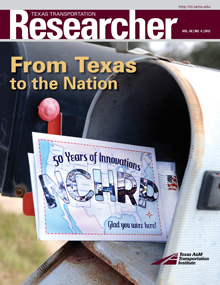
Freight transportation is a powerful cog in our nation’s economic engine. Given the critical role that freight transportation — cargo moved by air, rail, truck, water and pipeline — plays in the nation’s prosperity, freight movement disruptions can have severe economic and national security ramifications. Although much information exists on all aspects of freight movement and their intricacies, a comprehensive catalog of freight-related data sources does not exist.
“Freight transportation is a huge enterprise, and we don’t really have a clear, comprehensive picture of freight movements in this country,” says Cesar Quiroga, manager of the Texas A&M Transportation Institute’s (TTI’s) San Antonio Office. “Integrating all of that comprehensive data is vital for transportation planners and decision makers. Looking into what’s needed in order to develop a national freight data architecture was the basis of our two-year project.”
NCFRP Project 12: Guidance for Developing a Freight Transportation Data Architecture identified numerous benefits that could result from such an architecture. For example, coordinated data sharing would aid overlapping government jurisdictions by offering information about how freight activities might affect them as they initiate new transportation improvement projects. An integrated freight data architecture would also provide a better understanding of supply chains and business processes while potentially eliminating freight data redundancies and inefficiencies.
“It’s important to note that we weren’t attempting to develop the freight data architecture,” Quiroga says. “Our goal in this project was to develop the framework, requirements and specifications for the architecture.”
Quiroga and his team conducted surveys of planners, analysts, shippers and motor carriers to better understand their needs and how they use current data. Borrowing elements from other data architecture initiatives, the team defined a national freight data architecture as “the manner in which data elements are organized and integrated for freight- transportation-related applications or business processes. The data architecture includes the necessary set of tools that describe the related functions or roles, components where those roles reside or apply, and data flows and components at different domain and aggregation levels.”
Part of the research effort was to identify challenges that could hinder the implementation of a freight data architecture at the national level. For example, some freight stakeholders, particularly in the private sector, may be reluctant to share data with their government counterparts. Likewise, some data might be available from data aggregators, but accessing this information could be very expensive. Along with identifying challenges, the team developed a catalog of strategies and recommendations for dealing with those challenges.
“Building a comprehensive data architecture from the outset would be extremely difficult,” Quiroga explains. “That’s why we recommended starting with just one element of freight transportation, like commodity flows, and then building up the architecture using strategic stepping stones.”
According to Transportation Research Board Senior Program Officer Bill Rogers, funding has been approved for a new project tentatively entitled Implementing the Freight Transportation Data Architecture: Data Element Dictionary, which will create and define a catalog of current freight data elements currently being collected. The dictionary will provide managers of data programs with an invaluable reference for identifying differences among variables and building bridges among data sets.
“The work that TTI did on this project was vital in articulating the value of establishing an architecture for linking data across transport modes, subjects and levels of geography to obtain essential information for transportation decision making,” Rogers says.

